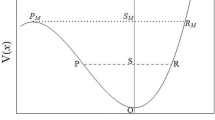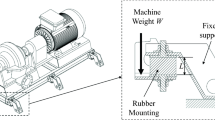Abstract
Models for nonlinear vibrations commonly employ polynomial terms that arise from series expansions about an equilibrium point. The analysis of symmetric systems with cubic stiffness terms is very common, and the inclusion of asymmetric quadratic terms is known to modify the effective cubic nonlinearity in weakly nonlinear systems. When using low (second, in this case)-order perturbation methods, the net effect in these cases is found to be a monotonic dependence of the free vibration frequency on the amplitude squared, with a single term that depends on the coefficients of the quadratic and cubic terms. However, in many applications, such a monotonic dependence is not observed, necessitating the use of techniques for strongly nonlinear systems, or the inclusion of higher-order terms and perturbation methods in weakly nonlinear formulations. In either case, the analysis involves very tedious and/or numerical approaches for determining the system response. In the present work, we propose a method that is a hybrid of the methods of averaging and harmonic balance, which provides, with relatively straightforward calculations, good approximations for the free and forced vibration response of weakly nonlinear asymmetric systems. For free vibration, it captures the correct amplitude–frequency dependence, including cases of non-monoticity. The method can also be used to determine the steady-state response of damped, harmonically driven vibrations, including information about stability. The method is described, and general results are obtained for an asymmetric system with up to quintic nonlinear terms. The results are applied to a numerical example and validated using simulations. This approach will be useful for analyzing a variety of system models with polynomial nonlinearities.




Similar content being viewed by others
Data Availability
Data will be made available by reasonable requests.
Notes
Note that the exact solution of the free oscillation given in Eq. (11) of Ref. [41] is obtained from an elliptic integral of the conservative system, and is expressed in terms of the total energy of the system \(E_\textrm{tot}\) rather than in terms of the amplitude of oscillation a. However, the relation between these two quantities is simply \(E_\textrm{tot}=\omega _0^2x_\textrm{max}^2/2+\alpha _2x_\textrm{max}^3/3+\alpha _3x_\textrm{max}^4/4\), where \(x_\textrm{max}=a+\sum _{k=0,k\ne 1}^{5}a_k\), and therefore, we can easily compute \(\omega _\textrm{exact}\) in terms of a.
References
Tiwari, S., Candler, R.N.: Using flexural MEMS to study and exploit nonlinearities: a review. J. Micromech. Microeng. 29(8), 083002 (2019)
Chakraborty, G., Jani, N.: Nonlinear dynamics of resonant microelectromechanical system (mems): a review. Mech. Sci. (2021). https://doi.org/10.1007/978-981-15-5712-5_3
Shoshani, O., Shaw, S.W.: Resonant modal interactions in micro/nano-mechanical structures. Nonlinear Dyn. 104(3), 1801–1828 (2021)
Bachtold, A., Moser, J., Dykman, M.: Mesoscopic physics of nanomechanical systems. arXiv preprint arXiv:2202.01819 (2022)
Touzé, C., Vizzaccaro, A., Thomas, O.: Model order reduction methods for geometrically nonlinear structures: a review of nonlinear techniques. Nonlinear Dyn. 105(2), 1141–1190 (2021)
Rosenberg, S., Shoshani, O.: Amplifying the response of a driven resonator via nonlinear interaction with a secondary resonator. Nonlinear Dyn. 105(2), 1427–1436 (2021)
Miller, N.J., Shaw, S.W., Dykman, M.: Suppressing frequency fluctuations of self-sustained vibrations in underdamped nonlinear resonators. Phys. Rev. Appl. 15(1), 014024 (2021)
Tepsic, S., Gruber, G., Møller, C., Magén, C., Belardinelli, P., Hernández, E.R., Alijani, F., Verlot, P., Bachtold, A.: Interrelation of elasticity and thermal bath in nanotube cantilevers. Phys. Rev. Lett. 126(17), 175502 (2021)
Krakover, N., Ilic, B.R., Krylov, S.: Micromechanical resonant cantilever sensors actuated by fringing electrostatic fields. J. Micromech Microeng. 32(5), 054001 (2022)
Defoort, M., Hentz, S., Shaw, S.W., Shoshani, O.: Amplitude stabilization in a synchronized nonlinear nanomechanical oscillator. Commun. Phys. 5(1), 1–7 (2022)
Perl, T., Maimon, R., Krylov, S., Shimkin, N.: Control of vibratory MEMS gyroscope with the drive mode excited through parametric resonance. J. Vib. Acoust. (2021). https://doi.org/10.1115/1.4050351
Xu, Q., Younis, M.I.: Micromachined threshold inertial switches: a review. J. Micromech. Microeng. (2022). https://doi.org/10.1088/1361-6439/ac6192/meta
Yaqoob, U., Jaber, N., Alcheikh, N., Younis, M.I.: Selective multiple analyte detection using multi-mode excitation of a MEMS resonator. Sci. Rep. 12(1), 1–14 (2022)
Rosłoń, I.E., Japaridze, A., Steeneken, P.G., Dekker, C., Alijani, F.: Probing nanomotion of single bacteria with graphene drums. Nat. Nanotechnol. 17, 1–6 (2022)
Lee, J., Shaw, S.W., Feng, P.X.L.: Giant parametric amplification and spectral narrowing in atomically thin MoS2 nanomechanical resonators. Appl. Phys. Rev. 9(1), 011404 (2022)
Mistry, K., Nguyen, V.H., Arabi, M., Ibrahim, K.H., Asgarimoghaddam, H., Yavuz, M., Muñoz-Rojas, D., Abdel-Rahman, E., Musselman, K.P.: Highly sensitive self-actuated zinc oxide resonant microcantilever humidity sensor. Nano Lett. (2022). https://doi.org/10.1021/acs.nanolett.1c04378
Potekin, R., Asadi, K., Kim, S., Bergman, L.A., Vakakis, A.F., Cho, H.: Ultrabroadband microresonators with geometrically nonlinear stiffness and dissipation. Phys. Rev. Appl. 13(1), 014011 (2020)
Houri, S., Asano, M., Okamoto, H., Yamaguchi, H.: Self-sustained libration regime in nonlinear microelectromechanical devices. Phys. Rev. Appl. 16(6), 064015 (2021)
Miller, J.M., Gomez-Franco, A., Shin, D.D., Kwon, H.K., Kenny, T.W.: Amplitude stabilization of micromechanical oscillators using engineered nonlinearity. Phys. Rev. Res. 3(3), 033268 (2021)
Czaplewski, D.A., Strachan, S., Shoshani, O., Shaw, S.W., López, D.: Bifurcation diagram and dynamic response of a MEMS resonator with a 1: 3 internal resonance. Appl. Phys. Lett. 114(25), 254104 (2019)
Keşkekler, A., Shoshani, O., Lee, M., van der Zant, H.S., Steeneken, P.G., Alijani, F.: Tuning nonlinear damping in graphene nanoresonators by parametric-direct internal resonance. Nat. Commun. 12(1), 1–7 (2021)
Asadi, K., Yeom, J., Cho, H.: Strong internal resonance in a nonlinear, asymmetric microbeam resonator. Microsyst. Nanoeng. 7(1), 1–15 (2021)
Kacem, N., Hentz, S., Pinto, D., Reig, B., Nguyen, V.: Nonlinear dynamics of nanomechanical beam resonators: improving the performance of NEMS-based sensors. Nanotechnology 20(27), 275501 (2009)
Kacem, N., Hentz, S.: Bifurcation topology tuning of a mixed behavior in nonlinear micromechanical resonators. Appl. Phys. Lett. 95(18), 183104 (2009)
Sobreviela, G., Vidal-Álvarez, G., Riverola, M., Uranga, A., Torres, F., Barniol, N.: Suppression of the Af-mediated noise at the top bifurcation point in a MEMS resonator with both hardening and softening hysteretic cycles. Sens. Actuator A Phys. 256, 59–65 (2017)
Polunin, P.M., Yang, Y., Dykman, M.I., Kenny, T.W., Shaw, S.W.: Characterization of MEMS resonator nonlinearities using the ringdown response. J. Microelectromech. Syst. 25(2), 297–303 (2016)
Huang, L., Soskin, S., Khovanov, I., Mannella, R., Ninios, K., Chan, H.B.: Frequency stabilization and noise-induced spectral narrowing in resonators with zero dispersion. Nat. Commun. 10(1), 1–10 (2019)
Qiao, W., Guo, T., Kang, H., Zhao, Y.: Softening-hardening transition in nonlinear structures with an initial curvature: a refined asymptotic analysis. Nonlinear Dyn. 107(1), 357–374 (2022)
Guckenheimer, J., Holmes, P.: Nonlinear Oscillations, Dynamical Systems, and Bifurcations of Vector Fields, vol. 42. Springer, Cham (2013)
Dykman, M., Mannella, R., McClintock, P.V., Soskin, S.M., Stocks, N.: Noise-induced narrowing of peaks in the power spectra of underdamped nonlinear oscillators. Phys. Rev. A 42(12), 7041 (1990)
Soskin, S.M., Mannella, R., McClintock, P.V.E.: Zero-dispersion phenomena in oscillatory systems. Phys. Rep. 373(4–5), 247–408 (2003)
Landau, L., Lifshitz, E.: Mechanics: Volume 1. Elsevier, New York (1982)
Nayfeh, A., Mook, D.: Nonlinear Oscillations. Wiley, New York (1995)
Krack, M., Gross, J.: Harmonic Balance for Nonlinear Vibration Problems. Springer, Cham (2019)
Cochelin, B., Vergez, C., Karkar, S.: Manlab, an Interactive Series-Expansion Approach for Continuation-Focus on Periodic Solutions. Galway, ESMC (2009)
Košata, J., del Pino, J., Heugel, T.L., Zilberberg, O.: HarmonicBalance. jl: A Julia suite for nonlinear dynamics using harmonic balance. arXiv preprint arXiv:2202.00571 (2022)
Shoshani, O., Dykman, M.I., Shaw, S.W.: Tuning linear and nonlinear characteristics of a resonator via nonlinear interaction with a secondary resonator. Nonlinear Dyn. 99(1), 433 (2020)
Nayfeh, A.H.: Perturbation Methods. Wiley, New York (2008)
Lifshitz, R., Cross, M.C.: Nonlinear dynamics of nanomechanical and micromechanical resonators. In: Schuster, H.G. (ed.) Reviews of Nonlinear Dynamics and Complexity. Wiley, New York (2008)
Volvert, M., Kerschen, G.: Phase resonance nonlinear modes of mechanical systems. J. Sound Vib. 511, 116355 (2021)
Rosenberg, S., Shoshani, O.: Zero-dispersion point in curved micro-mechanical beams. Nonlinear Dyn. 107(1), 1–14 (2022)
Wang, S., Tang, B.: A comparative study of parameter identification methods for asymmetric nonlinear systems with quadratic and cubic stiffness. Sensors 22(15), 5854 (2022)
Funding
This work is supported by BSF under Grant No. 2018041. SWS is also supported by NSF grant CMMI-1662619. OS is also supported by the Pearlstone Center of Aeronautical Engineering Studies at Ben-Gurion University of the Negev. S.R. acknowledges the financial support of the Kreitman school of advanced graduate studies at Ben-Gurion University of the Negev under the Negev-Tzin Scholarship. Just prior to submission, we learned of a concurrent formulation of a very similar technique by Mark Dykman that will be used in a forthcoming paper; discussions with him helped to clarify and expand our understanding of the approach.
Author information
Authors and Affiliations
Corresponding author
Ethics declarations
Conflicts of interest
The authors declare that they have no conflict of interest.
Additional information
Publisher's Note
Springer Nature remains neutral with regard to jurisdictional claims in published maps and institutional affiliations.
Transient dynamics
Transient dynamics
Here, we demonstrate the main shortcoming of the proposed approach, namely its inability to correctly capture the full transient dynamics. To this end, we numerically integrated both Eq. (2) and Eqs. (8)-(9) with identical initial conditions and compared their transient dynamics. To extract the amplitude a(t) and phase \(\phi (t)\) of the fundamental harmonic from Eq. (2), we heterodyned the numerically obtained signal x(t) with the in-phase and quadrature components at the drive frequency \(\omega \), and passed the mixed signals through a band-pass filter to remove the overtones and DC components [26]. We then use the resulting slowly-varying (with respect to \(\omega ^{-1}\)) quadratures of the fundamental harmonics, u(t) and v(t), to construct the amplitude and phase. The top panel of Fig. 4 depicts this process. The simulation results shown in the bottom panel of Fig. 4 clearly demonstrate that the transient dynamics from our analysis [Eqs. (8)-(9)] are distinctly different from those of the original system [Eq. (2)].
Rights and permissions
Springer Nature or its licensor (e.g. a society or other partner) holds exclusive rights to this article under a publishing agreement with the author(s) or other rightsholder(s); author self-archiving of the accepted manuscript version of this article is solely governed by the terms of such publishing agreement and applicable law.
About this article
Cite this article
Shaw, S.W., Rosenberg, S. & Shoshani, O. A hybrid averaging and harmonic balance method for weakly nonlinear asymmetric resonators. Nonlinear Dyn 111, 3969–3979 (2023). https://doi.org/10.1007/s11071-022-08065-3
Received:
Accepted:
Published:
Issue Date:
DOI: https://doi.org/10.1007/s11071-022-08065-3




